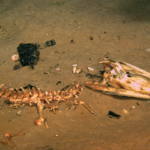![]() [Note the following post makes gratuitous use of keyboard symbols to denote adult language]
[Note the following post makes gratuitous use of keyboard symbols to denote adult language]
In the coolest titled paper ever “Assessing the apparent imbalance between geochemical and biochemical indicators of meso- and bathypelagic biological activity: What the @$#! is wrong with present calculations of carbon budgets?” with the world’s coolest handling editor, Burd et al tackle one of the major outstanding questions in ocean science.
When carbon arrives to the deep sea, organisms eat it and through a fancy set chemical reactions that I dare not go into use it to grow, reproduce, maintain themselves, and generally carry on their lives. That fancy set of reactions we all learned in high-school with hard to remember names like oxidative phosphorylation and so and so’s cycle, fall under the general blanket of metabolism.
There should be a balanced equation. Carbon into the deep equals metabolism by deep-sea organisms. Easy peezy and we move to the next step in modeling the global carbon cycle. But, and a very big one at that, both studies in the field and global carbon budgets indicates that metabolic activity in the deep exceeds the influx of organic material. What the @#$% indeed! Deep-sea animals are consuming more carbon than we can account for. So are we overestimating the amount they consume or not accounting for some secret magical carbon source?
Burd and colleagues suggest multiple things are throwing off our estimate and by accounting for them we might be able to reconcile the equation.
First, we don’t know $#!^ about deep-sea the metabolic activity of deep-sea animals. Well we know a little. But we don’t really have a handle on how they vary in time, across the deep ocean, across different animals, or even when deep-sea animals are happy or sad.
Second, we know @$#!’n little about how the food web of the deep-sea works. How is carbon transfered from organism to organism?
Third, we don’t know $#!^ about the biodiversity and carbon cycling through the pelagic zone.
And last, we know @$#!-all about all the ways carbon gets to the seafloor from the ocean’s surface. We quantify in sediment traps the amount that of carbon arriving vertically but any slow sinking particles, sporadic large carbon sources (i.e. dead whales), or carbon coming in sideways (we call this lateral advection) can go @$#! a rolling donut hole.
Burd, A., Hansell, D., Steinberg, D., Anderson, T., Arístegui, J., Baltar, F., Beaupré, S., Buesseler, K., DeHairs, F., & Jackson, G. (2010). Assessing the apparent imbalance between geochemical and biochemical indicators of meso- and bathypelagic biological activity: What the @$♯! is wrong with present calculations of carbon budgets? Deep Sea Research Part II: Topical Studies in Oceanography DOI: 10.1016/j.dsr2.2010.02.022






Sounds like there should be a quite a future in deep sea study after all!
Don’t forget $8!7 dropping from above! I mean, the biological carbon pump. How many organisms has this been quantified for?
$#&@!!! BEST PAPER TITLE EVAH. We’re really bad about quantifying rare, large events – who the $%&# knows when the *#&$*@@#$#@#* salps or the *#&$*@@#$#@#* diatoms are going to have a *#&$*@@#$#@#* bloom?
Does research blogging have a “bad language” tab? Seems like a must for today’s scientist!
All part of why deep sea ecology/biology is so @$!#%& fascinating – so many big questions and so many challenges!